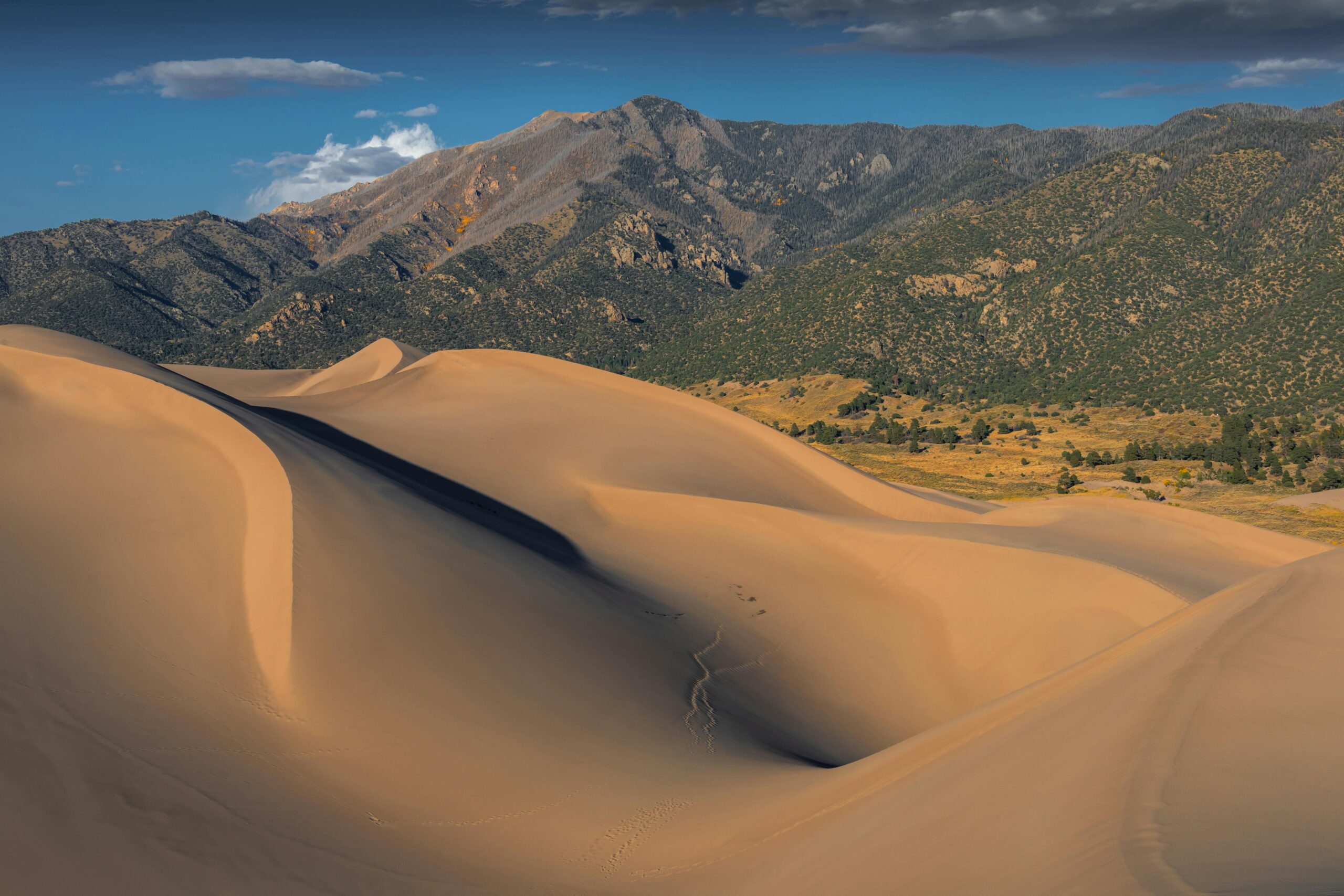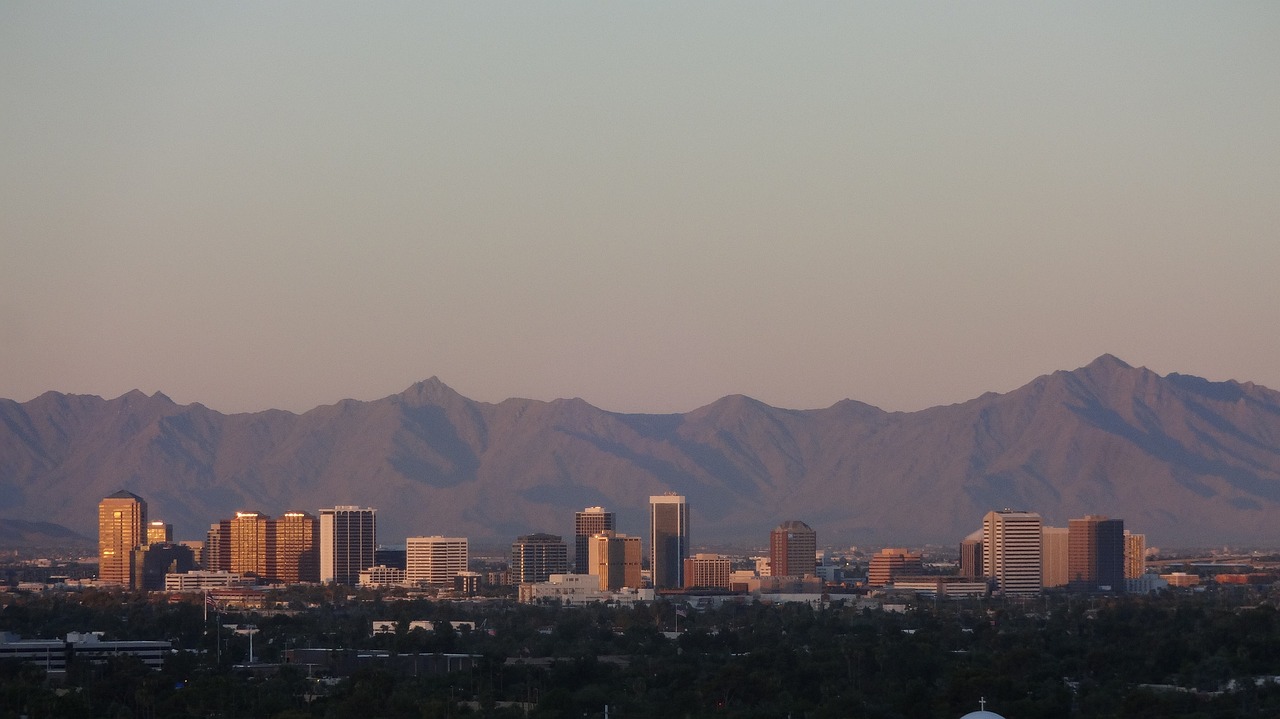
Looking for a unique vacation spot? Great Sand Dunes National Park is home to the tallest sand dunes in North America. This blog will show you what makes it special, from hiking to stargazing.
Get ready for adventure!
Key Takeaways
- Great Sand Dunes National Park has the tallest sand dunes in North America, reaching up to 750 feet. It’s in Colorado and offers many activities like hiking and sandboarding.
- The park is not just about sand dunes. It includes grasslands, wetlands, alpine lakes, and a diverse range of animals and plants.
- Activities at the park include hiking to High Dune for views of the entire park, sandboarding down steep slopes, stargazing at a designated Dark Sky Park, camping at Piñon Flats Campground with modern amenities, and wading in Medano Creek during spring or early summer.
- Different seasons offer unique experiences: wading in Medano Creek in spring/summer; less crowded times for photography in fall; peaceful exploration on snow-covered trails in winter.
- The area around the park also provides adventures. Visitors can explore Sangre de Cristo Wilderness Area’s diverse landscapes or climb Blanca Peak for stunning views.
Exploring the Great Sand Dunes

The Great Sand Dunes soar as the tallest dunes in North America, creating a diverse landscape of grasslands, wetlands, and alpine lakes. This natural wonder offers endless exploration with its unique terrain waiting to be discovered by adventurous travelers.
Tallest Sand Dunes in North America
Great Sand Dunes National Park in Colorado is home to the tallest sand dunes in North America. Some dunes reach up to 750 feet high. This makes them a giant playground for adventure seekers and nature lovers alike.
Visitors come from all over to see these massive hills of sand. They stand against a backdrop of mountains and clear blue skies, creating stunning views you can’t find anywhere else.
It’s a unique place where the desert meets the mountains, offering lots of photo opportunities.
Diverse Landscape: Grasslands, Wetlands, and Alpine Lakes
The park isn’t just about sand dunes. It’s home to grasslands, wetlands, and alpine lakes too. These areas support a wide variety of animals and plants. Deer roam the grasslands while ducks glide on the water.
Alpine lakes sit high up, near the mountains. They’re cold but very clear. In these spots, you might see birds that live high in the air or fish swimming deep in the water. Each part of this landscape offers something different to explore.
Activities at the Park
Visitors can conquer the tallest sand dunes in North America and explore a diverse landscape that includes grasslands, wetlands, and alpine lakes. From hiking to sandboarding to stargazing in the Dark Sky Park, the park offers an array of outdoor adventures for all ages.
Hiking to the High Dune
Great Sand Dunes National Park in Colorado is home to the tallest dunes in North America. Hiking to the High Dune offers stunning views and a memorable adventure.
- Start early in the morning to avoid the hot sun on the dunes.
- Bring plenty of water, as there are no sources along the hike.
- Wear sunscreen and sunglasses for protection against the sun.
- Use sturdy shoes that can handle sand; some prefer hiking sandals.
- The hike is about 2.5 miles round trip but feels longer due to climbing in sand.
- Expect it to take at least 2 hours, but it could be more based on your pace.
- The trail isn’t marked by signs, so follow the ridges and aim for the highest point you can see.
- Wind can change dune shapes overnight, making each hike unique.
- Once at the top, enjoy views of the entire park and Sangre de Cristo mountains.
- Take time for photos but keep your electronics safe from sand.
- Going downhill is faster and fun; some slide or run down gently.
- Be mindful of wildlife; though seldom seen during the day, they call this place home.
Hiking to High Dune is not just a walk. It’s an experience that shows off what makes Great Sand Dunes National Park special.
Sandboarding and Sand Sledding
At the Great Sand Dunes National Park in Colorado, you can enjoy sandboarding and sand sledding. Here’s what you need to know:
- Rent sandboards or sleds from shops outside the park.
- Head to the dunes and find a slope that suits your comfort level.
- Strap your feet onto the board or sled, and push off down the sandy hill.
- Feel the rush as you glide across the sand, similar to snowboarding or sledding on snow.
These activities are perfect for thrill-seekers and those looking for a unique adventure among North America’s tallest dunes.
Stargazing in the Dark Sky Park
At the Great Sand Dunes National Park, you can enjoy exceptional stargazing in the designated Dark Sky Park. It’s a unique experience that allows you to witness an incredible celestial display due to minimal light pollution.
Here, you can see thousands of stars twinkling brightly on clear nights, as well as planets and even meteor showers during peak times.
The park regularly hosts astronomy programs, led by knowledgeable rangers who provide telescopes for visitors to use and also offer educational insights into the night sky. Whether you’re an avid stargazer or simply curious about the cosmos, this is a fantastic opportunity to admire the beauty of the universe above Colorado’s stunning sand dunes.
Camping at Piñon Flats Campground
Camping at Piñon Flats Campground offers a peaceful retreat surrounded by beautiful landscapes. Here’s what you can expect:
- Spacious Campsites: Choose from 88 individual sites, each equipped with a picnic table and a fire grate.
- Modern Amenities: Access clean restrooms with flushing toilets and potable water.
- Convenient Location: The campground is situated near the park entrance, providing easy access to hiking trails and the dunes.
- Stunning Scenery: Enjoy magnificent views of the Sangre de Cristo Mountains and the expansive grasslands from your campsite.
- Night Skies: Experience exceptional stargazing opportunities in the dark sky environment of the campground.
Camping at Piñon Flats Campground grants travelers an opportunity to connect with nature while enjoying modern comforts amidst breathtaking surroundings.
Wading in Medano Creek
Medano Creek, known for its shallow and flowing waters, offers a delightful experience for all ages. Here are the highlights of wading in Medano Creek:
- Gentle Flow: The creek’s calm and gentle flow makes it ideal for wading and splashing around without strong currents.
- Family-Friendly: Perfect for families, children can safely play in the clear water while parents relax on the sandy banks.
- Natural Water Park: Enjoy the natural “beach” atmosphere with expanses of sand and shallow pools, creating a unique aquatic playground.
- Seasonal Flow: In spring and early summer, witness the creek at its peak as it carries snowmelt from the Sangre de Cristo Mountains.
- Refreshing Retreat: A perfect spot to cool off during hot summer days, offering a refreshing break from exploring the dunes.
- Scenic Setting: Surrounded by stunning views of the dunes and mountains, creating a picturesque backdrop to your water activities.
Let’s move on to explore “Seasonal Highlights” next!
Seasonal Highlights
Spring and summer at the Great Sand Dunes bring Medano Creek adventures, where you can wade through gentle waters. In fall, seize stunning photography opportunities in the midst of vibrant foliage.
In winter, enjoy peaceful exploration and snow-covered trails.
Spring and Summer: Medano Creek Adventures
Enjoy the warm seasons by wading in Medano Creek at Great Sand Dunes National Park. From late spring through early summer, the shallow waters are perfect for splashing and experiencing a unique “surge flow” phenomenon caused by melting snow from the Sangre de Cristo Mountains.
This is an excellent time for families to play in the water and relax on the sandy beach. The flow varies throughout these months but usually peaks around late May to June, providing refreshment and fun amidst stunning natural surroundings.
When planning your trip to Great Sand Dunes National Park during spring or summer, be sure to experience this enchanting creek before diving into more park adventures. Whether you’re sandboarding, hiking, or simply enjoying nature’s beauty, Medano Creek adds another layer of delight to your visit.
Next up: Fall: Stunning Photography Opportunities
Fall: Stunning Photography Opportunities
Fall at Great Sand Dunes National Park brings stunning photography opportunities. The changing colors of the grasslands and trees against the backdrop of the sand dunes create a mesmerizing sight for photographers.
The park is less crowded, giving ample space for capturing unique shots without interruptions.
The crisp fall air enhances visibility, making it ideal for capturing clear and vivid photographs. As the sun sets lower in the sky during fall months, it creates beautiful lighting conditions that are perfect for photography enthusiasts seeking to capture breathtaking landscapes.
Winter: Peaceful Exploration and Snow-Covered Trails
Winter at Great Sand Dunes National Park offers a tranquil experience with snow blanketing the trails and dunes. The park’s elevation allows for ample snowfall, creating a serene environment perfect for peaceful exploration.
Visitors can enjoy cross-country skiing or snowshoeing through a winter wonderland while taking in the breathtaking views of the Sangre de Cristo Mountains. The normally bustling park becomes hushed and calm during this time, making it an ideal destination for those seeking solitude amidst stunning natural beauty.
The cold season provides unique opportunities to witness the stark contrast between the golden sands and pristine white snow, adding an extra layer of allure to the park’s already diverse landscape.
It’s also an excellent time for photography enthusiasts to capture stunning images of this rare juxtaposition between sand and snow. Additionally, winter camping is available at Piñon Flats Campground, offering intrepid travelers a chance to experience the magic of the snowy dunes firsthand.
Geology and Formation of the Sand Dunes
The Sand Dunes were shaped by natural forces. The terrain’s unique features make for an intriguing exploration.
How the Dunes Were Formed
Around 440,000 years ago, the Great Sand Dunes began forming. Wind and water carried sand particles from the surrounding mountains and dried-up ancient lakes towards the San Luis Valley.
Over time, these sediments piled up against the Sangre de Cristo Mountains – creating this unique landscape. The dunes are made of quartz sand which originates from the nearby mountains and were left behind when ancient lakes dried up.
This natural wonder continues to evolve as winds shape its peaks and valleys, with Medano Creek acting as a contributor to their formation during spring snowmelt. This process plays a crucial role in maintaining the dune field’s structure by redistributing sand across different parts of the park each year.
As we delve into exploring this remarkable geological feature, knowing how it came to be adds another layer of appreciation for its beauty and significance within our planet’s diverse landscapes.
Unique Features of the Terrain
The Great Sand Dunes National Park stands out for its diverse terrain, showcasing not just massive sand dunes but also grasslands, wetlands, and alpine lakes. The park boasts the tallest sand dunes in North America, reaching heights of about 750 feet.
Furthermore, the landscape is a blend of ecosystems including tundra, forests, and alpine lakes set against the stunning backdrop of the Sangre de Cristo mountains. This unique mix makes exploring this area an adventure like no other in the country.
Nearby Attractions
Explore the surrounding Sangre de Cristo Wilderness Area, where you can discover diverse ecosystems and stunning panoramic views of the dunes. The nearby Blanca Peak offers a challenging yet rewarding hike for outdoor enthusiasts seeking breathtaking alpine scenery.
Sangre de Cristo Wilderness Area
Sangre de Cristo Wilderness Area is adjacent to Great Sand Dunes National Park and offers diverse landscapes of alpine lakes, forests, and rugged peaks. This area provides opportunities for hiking, birdwatching, and experiencing the raw beauty of Colorado’s natural wilderness.
The Sangre de Cristo Mountains stand tall as a backdrop to the dunes, creating a stunning contrast between the sandy terrain and snow-capped peaks. It’s a haven for nature enthusiasts seeking serenity away from bustling city life.
The Sangre de Cristo Wilderness Area spans over 220,803 acres within the San Isabel and Rio Grande National Forests and stands out as one of Colorado’s most pristine natural habitats.
The area is perfect for those who wish to immerse themselves in untouched wilderness while exploring unique ecosystems that house diverse flora and fauna.
Blanca Peak
Blanca Peak is the fourth highest summit in Colorado, towering at 14,345 feet. It’s part of the Sangre de Cristo mountain range and offers magnificent views of the Great Sand Dunes National Park.
The peak provides an excellent opportunity for hikers and climbers to challenge themselves with its rugged terrain and stunning alpine environment. Furthermore, it’s a prominent feature of the park’s landscape that adds to the overall experience for outdoor enthusiasts.
The peak is known for its winter ascents attracting those seeking a peaceful exploration amid snow-covered trails. Additionally, it serves as a gateway to Sangre de Cristo Wilderness Area where visitors can immerse themselves in pristine natural surroundings and enjoy various recreational activities such as hiking and wildlife watching.
San Luis State Wildlife Area
San Luis State Wildlife Area, situated near the Great Sand Dunes National Park in Colorado, offers a captivating natural experience. This wildlife area encompasses 6,820 acres of diverse landscapes including wetlands and lush grasslands.
Visitors can witness an array of wildlife species such as waterfowl, raptors, and migratory birds while exploring the beautiful expanse. The Blanca Wetlands within the area provide a vital habitat for various bird species with over 185 identified bird varieties.
The San Luis State Wildlife Area also features numerous recreational activities like fishing in stocked lakes or walking along serene nature trails. It’s an idyllic spot for birdwatching enthusiasts where around 100 different bird species have been recorded annually.
Notably, during the winter months, visitors can enjoy ice fishing on Lake Dorothey while taking in breathtaking views of Mount Blanca and the Sangre de Cristo Mountains as their backdrop.
Tips for Visiting
Plan your visit during spring or early summer for the best Medano Creek adventures and mild temperatures, but be prepared for high winds; consider fall for stunning photography opportunities and winter for peaceful exploration with snow-covered trails.
Explore these tips to make the most of your trip!
Best Times to Visit the Dunes
The best times to visit the Great Sand Dunes National Park are in spring and early summer, as Medano Creek swells from snowmelt, creating a unique beach-like experience at the base of the dunes.
Fall is also a great time for photographers, with cooler temperatures and changing foliage providing stunning vistas. Winter offers serene exploration and snow-covered trails but be prepared for cold weather.
It’s less crowded during this time, offering peaceful outdoor experiences amidst the sand dunes and surrounding landscapes. Each season brings its own charm to experience at the park.
These seasonal highlights offer various adventures — from creek wading to photography opportunities against a backdrop of vibrant fall colors or tranquil winter scenes. The different seasons transform the landscape, presenting visitors with versatile experiences throughout the year.
Consider these factors when planning your visit to fully savor what each season has to offer at Great Sand Dunes National Park in Colorado.
Navigating the Ecosystems and Climate
After understanding the best times to visit the dunes, it’s essential to consider how to navigate the diverse ecosystems and changing climate of Great Sand Dunes National Park. The park is home to a variety of landscapes, including grasslands, wetlands, alpine lakes, forests, and tundra due to its location within Colorado.
The elevation ranges from 7,500 feet (2,286 meters) at the visitor center to over 13,000 feet (3,962 meters) in the Sangre de Cristo Mountains.
When exploring this varied terrain and differing climate conditions throughout the year at Great Sand Dunes National Park in Colorado state, visitors are advised to be prepared for temperature changes.
For example; during summer months when temperatures can reach up into high 90s Fahrenheit(30 °C), it’s important for guests bring plenty of water and protective clothing such as hats and sunscreen for sun protection especially when hiking or sand-boarding on sunny days Similarly during fall or winter where nights can drop below freezing points with daytime temperatures varying greatly hence carrying layering clothes is advisable totaling up that one must pack accordingly based on seasonal demands.
Safety Precautions for Outdoor Activities
When partaking in outdoor activities at Great Sand Dunes National Park, it’s crucial to prioritize safety. The park’s diverse landscape presents various challenges and considerations.
For hiking, always carry plenty of water, wear sturdy shoes for sand terrain, and be mindful of sudden weather changes. When engaging in sandboarding or sand sledding, wearing protective gear including helmets is essential to prevent injuries.
Furthermore, stargazing at the Dark Sky Park requires using designated areas and staying aware of surroundings due to minimal lighting. When camping at Piñon Flats Campground, adhering to fire regulations is crucial for wildfire prevention.
Moreover, while wading in Medano Creek during spring and summer, being cautious of swift currents caused by snowmelt is important for personal safety. Always stay informed about seasonal conditions prior to engaging in any activity within the park.
Conclusion
Great Sand Dunes National Park in Colorado offers an incredible experience for nature enthusiasts. With the tallest sand dunes in North America and a diverse landscape including grasslands, wetlands, and alpine lakes, there’s something for everyone.
From sandboarding to stargazing, the park provides a range of activities throughout the year. Visitors can also explore nearby attractions like Sangre de Cristo Wilderness Area and Blanca Peak.
Whether it’s spring or winter, this park promises unique adventures and stunning scenery for all who visit.
FAQs
1. What makes Great Sand Dunes National Park special?
Great Sand Dunes National Park is famous for its towering sand dunes, which are the tallest in North America. Visitors can enjoy unique landscapes, diverse wildlife, and beautiful mountains nearby.
2. How do I get to Great Sand Dunes National Park?
You can reach Great Sand Dunes National Park by car. It’s located in southern Colorado, near the town of Alamosa. Follow Highway 160 and then take Route 150 south to enter the park.
3. What activities can I do at Great Sand Dunes?
At Great Sand Dunes, you can hike on the dunes, go sandboarding or sledding down them, and explore trails through forests and wetlands. Stargazing at night is also a popular activity due to low light pollution.
4. When is the best time to visit Great Sand Dunes National Park?
The best time to visit is from late spring to early fall when temperatures are warmer and conditions are ideal for outdoor fun. However, each season offers something different—from snow-capped peaks in winter to blooming wildflowers in spring!







Leave a Reply